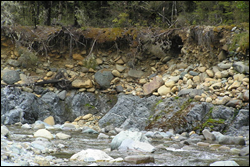River bank styles
Research Status: Ongoing |
High bank in Moutere Gravels |
Introduction
The stability of a river or stream bank is a complex interaction of processes happening within the channel and those on and near the bank. Vegetation is often used to control or stabilise river banks.
From our field observations of rivers and streams within the Motueka River and its tributaries, and from looking at the role of vegetation and how it controls (or not) river bank erosion we posited that it might be possible to develop a simple field-based assessment of a river bank’s stability based on its morphology or form. Further we suggested that it might be possible from such a simple assessment of bank form, the likelihood that vegetation would stabilise that bank. Our current work is aiming to determine if it is possible to devise a simple system - stream bank styles - that could be used to determine the current bank stability and stabilisation potential by vegetation.
Research Approach
- Literature review
- Field assessment of shape/form of river banks across a wide range of geologies and stream sizes
- Analysis of a range of factors to determine the likelihood of any relationships that might help predict the likely situations where vegetation would be a prime candidate for bank stabilisation.
Research Results
At December 2007: a preliminary report is underway and further field assessment is due to be done in early 2008 to clarify the approach.
 |
 |
River bank |
River bank showing alluvium-bedrock boundary |
Recent Publications
Recent Presentations
BMPs, BEPs and Guidelines
| Title | Description |
| Soil Conservation Technical Handbook | The Soil Conservation Technical Handbook is a comprehensive collection of know how about soil conser...More » |
| Best practice guidelines for vegetation management and in stream works | These best practice guidelines cover activities undertaken by the River and Catchment Services group...More » |
Primary Contacts:

|
Michael Marden
Email Phone: 06 8631345 Fax: 06 8631346 More details» |
Institute Landcare Research |
Expertise Geology/Earth Sciences/Geomorphology/Erosion processes |

|
Chris Phillips
Email Phone: +64 3 321 9775 More details» |
Institute Landcare Research |
Expertise Erosion processes, slope stability, effects of forestry, catchment management, knowledge management |